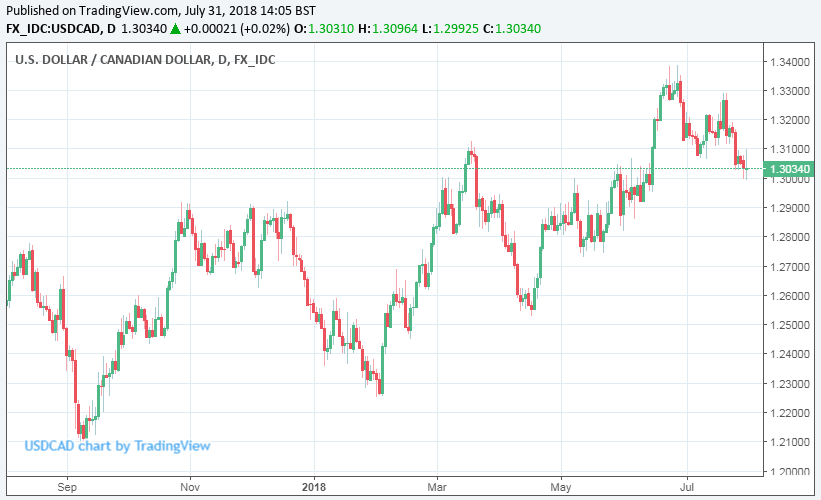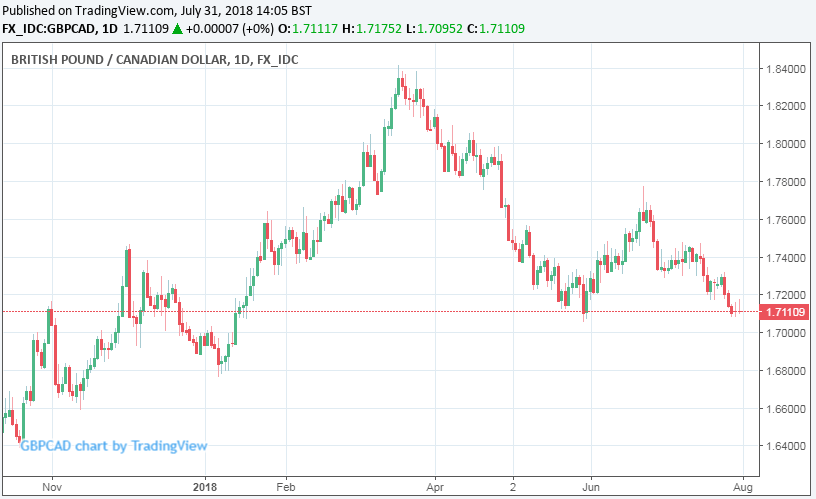Canadian Dollar Reverses Losses and Shakes of NAFTA Blues after Data Shows Growth Surging in May
- Written by: James Skinner
-
-CAD rises after GDP data shows sharp growth uptick in May.
-Analysts now forecast an October interest rate rise from the BoC.
-But gains to be kept in check by continued NAFTA uncertainty.

© COSPV, Adobe Stock
The Canadian Dollar reversed earlier losses and marched higher Tuesday after official data showed economic growth picking up much faster than was expected during May, prompting some analysts to look again at thier forecasts for Bank of Canada interest rates.
Canadian economic growth rose by 0.5% between the end of April and May, up from 0.1% previously, when markets had been looking for only a 0.3% gain. This puts Canada's economy on track to achieve annualised growth of around 3% for the second quarter overall.
Statistics Canada says 19 out of 20 industrial sectors all saw growth during the month of May, with mining, quarrying and energy sectors leading the way. Services industries all did well too. Although analysts have said uncertainty over the North American Free Trade Agreement means any GDP-induced gains for the Loonie will be kept in check for the time being.
"April showers brought May flowers for the Canadian economy, as better weather and healthy gains in a broad range of sectors added up to a strong month of growth. Real GDP hit our projected 0.5% gain, which was two ticks above consensus, and after a tame 0.1% gain was enough to put the second quarter on pace for roughly 3% growth even with a soft June," says Avery Shenfeld, chief economist at Toronto-headquartered CIBC Capital Markets.
Currency markets care about the GDP data because economic growth has a direct bearing on inflation and it is changes in consumer price pressures that central banks are attempting to manipulate when they tinker with interest rates, which are themselves the raison d'être for most swings in exchange rates.
Changes in interest rates, or hints of them being in the cards, are only normally made in response to movements in inflation but impact currencies because of the push and pull influence they have on international capital flows and their allure for short-term speculators.
"The Bank of Canada already hiked once in anticipation of a strong q2, and will likely want to see at least the first readings on Q3 to ensure this isnt just a blip quarter after three quarters averaging only 1 1/2%. That suggests that barring bad news on the NAFTA or auto tariff front, the Bank of Canada will be raising rates in October, which is now our call," Shenfeld adds.

Above: USD/CAD rate shown at daily intervals.
The USD/CAD rate was quoted 0.12% lower at 1.3012 following the release Tuesday after reversing an earlier 0.05% gain, while the Pound-to-Canadian-Dollar rate was 0.07% lower at 1.7100 after reversing a 34% increase.
The Canadian Dollar also reversed losses against all other G10 currencies except for the Euro and Australian Dollar following the report.

Above: Pound-to-Canadian-Dollar rate shown at daily intervals.
Most measures of Canadian inflation are already at or above the Bank of Canada's (BoC) 2% target while the Bank said in July that it expects this to remain the case out until at least 2020.
The BoC raised its interest rate for the fourth time in the last 12 months this July, taking it up to 1.5%, and signalled its intention to continue withdrawing stimulus from the Canadian economy over the coming quarters.
"The GDP report will be closely monitored given the Bank's sensitivity to growth," says Mark McCormick, North American head of FX strategy at Toronto-headquartered TD Securities. "We think the bar is low for the data to offer some temporary support for CAD, given that positioning in the G10 looks increasingly one-sided. The USD has also failed to make fresh highs, suggesting some room for a tactical rebound."
Canada's economy grew by 0.1% during the April month, down from 0.3% in March, when markets had been looking for it to stall. This put the economy on track to expand at an annualised pace of between 2% and 2.5% during the second quarter overall.
April's GDP data also drew a clear line beneath a first-quarter slowdown that saw the economy contract in January. Any further increase in the pace of growth during May could be enough to encourage the market to bet more heavily that the BoC will follow July's interest rate move with another before the year is out.
"Positive surprises could see USD/CAD breach the 1.30 level amid a generally neutral USD environment," says Viraj Patel, an FX strategist at ING Group, in a note ahead of the release. "But any move could be quickly faded given the limited appetite to chase CAD higher until NAFTA uncertainties are fully off the table."
Advertisement
Get up to 5% more foreign exchange by using a specialist provider to get closer to the real market rate and avoid the gaping spreads charged by your bank when providing currency. Learn more here
NAFTA Threat Still Looms Large
Tuesday's data comes amid reports that Canadian foreign minister Chrystia Freeland was excluded from a round of talks about the North American Free Trade Agreement (NAFTA) in Washington last week, highlighting the threat still posed by to the Loonie by the NAFTA stalemate.
Freeland's requests to join the meeting between US Trade Representative Robert Lightizer and Mexican officials were either "ignored outright or spurned".
This comes after President Donald Trump, Lightizer and White House economic adviser Larry Kudlow each suggested at various points in the last month that individual trade deals could be preferrable to a renegotiated NAFTA.
Officials from all sides of the US-Canada-Mexico borders have been attempting, without success, to renegotiate the North American Free Trade Agreement for nearly a year now.
The talks were organised after President Donald Trump criticised the NAFTA pact, which facilitates tariff-free trade between its signatories, and threatened to withdraw from it unless more terms more palatable to the administration can be agreed.
Analysts have previously estimated a US withdrawal from NAFTA could see the Canadian Dollar fall by 20%. The BoC also frequently flags the trade saga as a significant risk to investment and economic growth.
"We go long CAD/JPY as CAD is typically a beneficiary of month-end related USD selling. Our economists also see upside risk into the May GDP report in Canada tomorrow," says Adam Cole, chief currency strategist at Toronto-headquartered RBC Capital Markets, in a note Monday.
Cole and the RBC team are betting on a rise of the Canadian Dollar relative to the Japanese Yen largely becuase they say the Bank of Japan will disappoint against lofty market expectations for a change in its monetary policy this week. But month-end flows and the prospect of a surprisingly strong GDP number Tuesday are also factors in their "Trade of the Week".
Advertisement
Get up to 5% more foreign exchange by using a specialist provider to get closer to the real market rate and avoid the gaping spreads charged by your bank when providing currency. Learn more here





